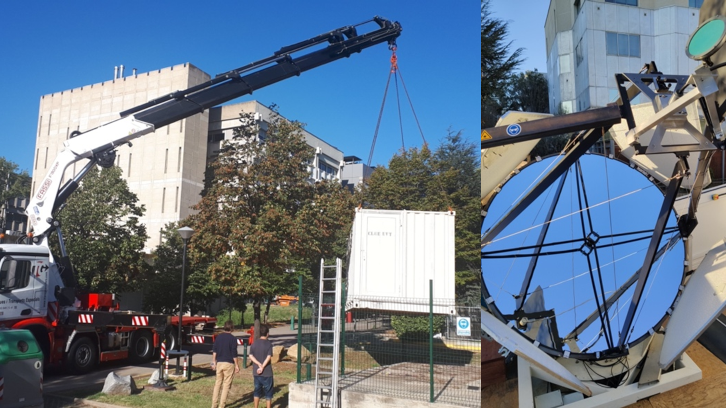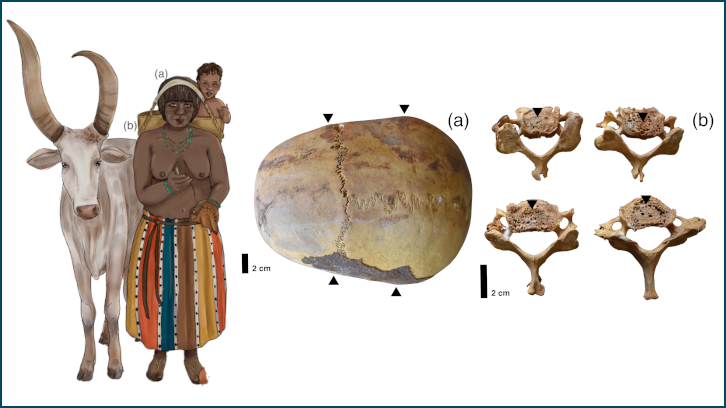The largest LIDAR prototype for astronomical use has been developed at the UAB

Hidden inside a shipping container on the UAB Campus, the Barcelona Raman LIDAR is a laser system developed to measure the atmosphere and support the telescope array network of the Cherenkov Telescope Array Observatory. The UAB Department of Physics has evaluated the system’s technical performance and the results from several data taking campaigns, including the analysis of the Cumbre Vieja volcanic eruption.
Have you ever wondered what is hidden inside the shipping container found at the UAB Campus, close to the northern entrance of the Faculty of Science, in front of the IFAE workshop?
Members of the UAB, under the subsequent leaderships of Prof. Lluís Font, Prof. Markus Gaug (both UAB & CERES-IEEC), Dr. Oscar Blanch and Dr. Manel Martinez (both IFAE) have been working during the past ten years to develop a new type of LIght Detection And Ranging (LIDAR): the Barcelona Raman LIDAR (BRL). It is specifically designed for the needs of the northern site of the Cherenkov Telescope Array Observatory (CTAO), located at the Observatorio del Roque de los Muchachos (ORM) on the Canary Island of La Palma (Spain) and currently under construction. That design and a first evaluation of its capabilities were recently published in two articles in the journal Remote Sensing.
LIDARs use powerful lasers to shoot short pulses of light into the atmosphere and capture the backscattered light with large mirrors (1.8m diameter in this case). The design developed for the BRL consists of a laser operating at two wavelengths emitted simultaneously in the same direction and a specifically designed light detection unit that separates the returned light into four different wavelengths. This is needed, because the BRL not only detects elastically backscattered, but also Raman-scattered light, in which the scattering process is inelastic and changes the wavelength of the light.
The first paper1 we present, led by PhD student Anna Campoy Ordaz (UAB & CERES-IEEC), describes the technical details of the system and a series of measurements to characterize its behaviour, including parts of several PhD theses defended at the UAB (Camilla Maggio, Merve Sidica Çolak and Alicia López Oramas) and nine bachelor theses, whereas the second paper2, led by Markus Gaug, details a newly developed analysis and presents results from different data taking campaigns, with important contributions from Roger Grau Haro (IFAE) and Anna Campoy Ordaz (UAB & CERES-IEEC). One of the campaigns was carried out during a one-year stay of the BRL at the ORM, close to its final location. During that period, the Cumbre Vieja volcano broke out, delivering very interesting data from the volcanic dust plume that travelled over the site. Analysis of these data was particularly useful to confirm the performance metrics of the BRL.
The Barcelona Raman LIDAR during data taking at night at the Observatorio del Roque de los Muchachos.
Department of Physics
Universitat Autònoma de Barcelona
References
1Ballester, O.; Blanch, O.; Boix, J.; Calisse, P.G.; Campoy-Ordaz, A.; Çolak, S.M.; Da Deppo, V.; Doro, M.; Font, L.; Font-Pladevall, E.; et al. (2025). A 1.8 m Class Pathfinder Raman LIDAR for the Northern Site of the Cherenkov Telescope Array Observatory—Technical Design. Remote Sens. 17, 1074. https://doi.org/10.3390/rs17061074
2Bauzá-Ruiz, P.J.; Blanch, O.; Calisse, P.G.; Campoy-Ordaz, A.; Çolak, S.M.; Doro, M.; Font, L.; Gaug, M.; Grau, R.; Kolar, D.; et al. (2025). A 1.8 m Class Pathfinder Raman LIDAR for the Northern Site of the Cherenkov Telescope Array Observatory—Performance. Remote Sens. 17, 1815. https://doi.org/10.3390/rs17111815


